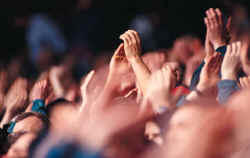Applause Physics

Theater audiences who break into synchronized, rhythmic applause are showing more than just their appreciation–they’re also revealing their grasp of some sophisticated physics, according to the June issue of Physical Review E. By analyzing recordings from European theaters and concert halls, a team has shown that an audience’s ability to make rhythmic applause appear and disappear constitutes a new form “spontaneous synchronization” previously unrecognized in real-life systems.
The emergence of rhythmic behavior from initially random pulses is a phenomenon seen throughout nature, from the beating of heart cells to the flashes of fireflies. Theorists have explained the phenomenon with mathematical models and computer simulations of collections of oscillators coupled to one another, rather like a series of connected, identical pendulums. Under the right conditions, such pendulums become synchronized.
Zoltan Néda of Babes-Bolyai University in Cluj-Napoca, Romania, and his colleagues have now discovered that rhythmic applause constitutes a new form of this phenomenon, one explained by a model put forward by Japanese theorists in the late 1980s. As one might expect, this model predicts that rhythmic behavior emerges only when the coupling between oscillators is strong enough: Audience members must be sufficiently aware of changes in the clapping rates of others if rhythmic clapping is to occur. But the model also predicts that this critical coupling level depends crucially on the dispersion of the applause–that is, the spread in clapping rates of the audience. An audience with a wide variety of rates will not be sufficiently well-coupled to sustain rhythmic applause.
To find out if this “dispersion dependent coupling” explains the real-life phenomenon, the team recorded applause in various settings, from theaters and opera houses in Romania and Hungary to individuals, to discover the styles of clapping that accompany both disorganized and rhythmic applause. These data revealed that audiences seeking rhythmic applause do indeed make their clapping rates more uniform, just as theory demands. And once the uniformity reaches a critical level, the whole audience can tell what is going off, and really tight, rhythmic clapping sets in.
So why does it often vanish again? According to Néda, slow, rhythmic applause isn’t as raucous as fast, random clapping. The lower sound level prompts enthusiastic audience members to break ranks with the others and increase the spread of clapping rates beyond the point where rhythmic applause is sustainable. So the applause returns to a sea of noise.
Néda and his colleagues point out that savvy audiences can make rhythmic applause appear and disappear at will by altering the speed and spread of their clapping. This, as the researchers wryly note, seems to explain why rhythmic applause was so common at Communist Party meetings: Once it had broken out, audiences rarely felt enthusiastic enough to clap harder and turn the rhythm back into raucous applause.
This demonstration of a new route to spontaneous synchronization is consistent with other work on coupled oscillators in real life, says Ian Stewart of Warwick University in Coventry, England. “What we’re learning is that synchronization might sound a simple thing to achieve, but how one gets there can be surprisingly subtle.” To understand it, he says, one must follow the example of Néda and his colleagues, “and study not just the synchronized and unsynchronized states, but the fine detail of the transition between them.”
–Robert Matthews
Robert Matthews is science correspondent for the Sunday Telegraph, London, UK.


